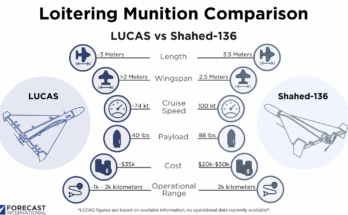
This past February, an advanced self-protection system for helicopters, in development for over 10 years, reached a transformative milestone. Northrop Grumman Corporation’s Common Infrared Countermeasures (CIRCM) system achieved Initial Operational Capability. With IOC, the U.S. Army demonstrated the ability to field, employ and maintain CIRCM in significant quantities on its rotary- wing platforms. This milestone advances the accelerated fielding of CIRCM systems on more than 1,500 Army aircraft. CIRCM has met the IOC requirements for UH-60Ms, HH-60Ms, CH-47Fs and AH-64Es. The number will likely rise with increased demand over the next few years.
CIRCM replaces the previous, widely distributed Advanced Threat IRCM (ATIRCM) system.
The system could possibly also see installations on the Future Vertical Lift (FVL) aircraft, Future Aerial Reconnaissance Aircraft (FARA), and Future Long-Range Assault Aircraft (FLRAA).

A next-generation system, CIRCM protects against shoulder-fired and vehicle-launched anti-aircraft missiles that home in on the heat signature of an aircraft. The system works in conjunction with a common missile warning system (CMWS) to offer a critically vital form of self-protection for aircraft and the personnel who operate them.
In April 2021, the U.S. Army awarded prime contractor Northrop Grumman a five-year, indefinite delivery/indefinite quantity (IDIQ) contract valued at $959.1 million for full-rate production of the CIRCM system.
Russia’s invasion of Ukraine in February and the ongoing war have provided stark demonstrations of the helicopter’s unique vulnerability to ground fire. This and previous lessons have only spurred strong support for CIRCM’s long development path over the previous decade and into its current, accelerated, production and installation phase.
The FY24 U.S. defense budget includes $1.5 billion in CIRCM procurement funding through FY28 – including purchases of support equipment and other costs.
For now, production is primarily for the U.S. Army. However, if the history of its associated and widely distributed CMWS is any indicator, later years may see production for U.S. aircraft sold through the Foreign Military Sales program to trusted allies.
The multibillion-dollar CIRCM program is now covered in a newly published report, found in Forecast International’s Electronic Warfare and Electro-Optical Systems Forecasts, both featuring long-range funding and production outlooks.
Andrew Dardine is lead analyst for Forecast International's Defense Electronic Systems group. He is the primary author of Forecast International's Electronic Warfare Forecast and co-author of Electro-Optical Systems Forecast and C4I Forecast. Andrew is also a regular contributor to FI's Defense & Security Monitor blog, offering insights into developing technologies such as directed-energy and next-generation jamming systems. His analysis of such vital market areas as EO/IR systems and electronic countermeasures technology has been cited in Defense News, Aerospace Daily, and Bloomberg Businessweek, among other news media. He has also written about the electronic defense market for Aviation Week and the Journal of Electronic Defense.




